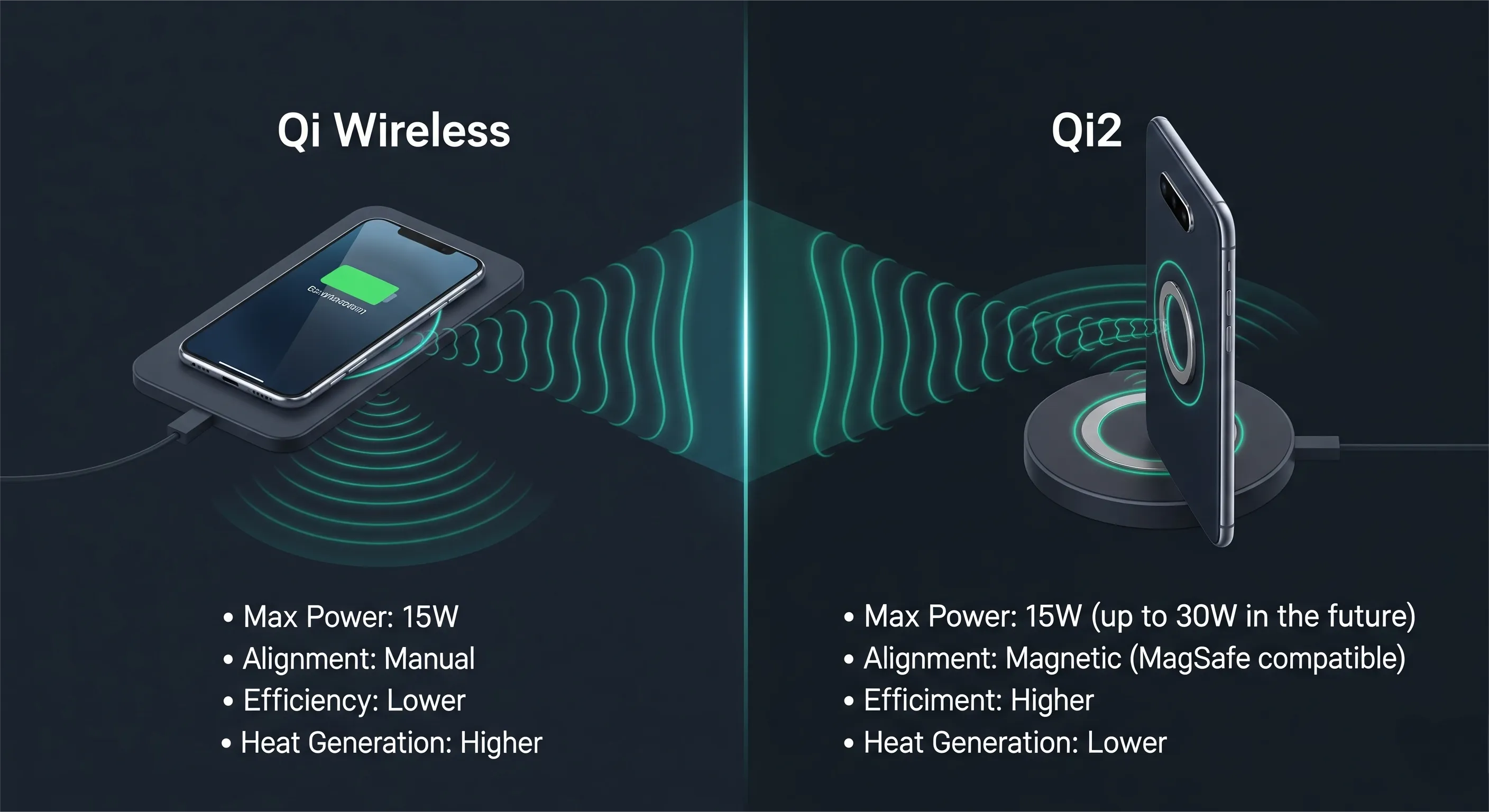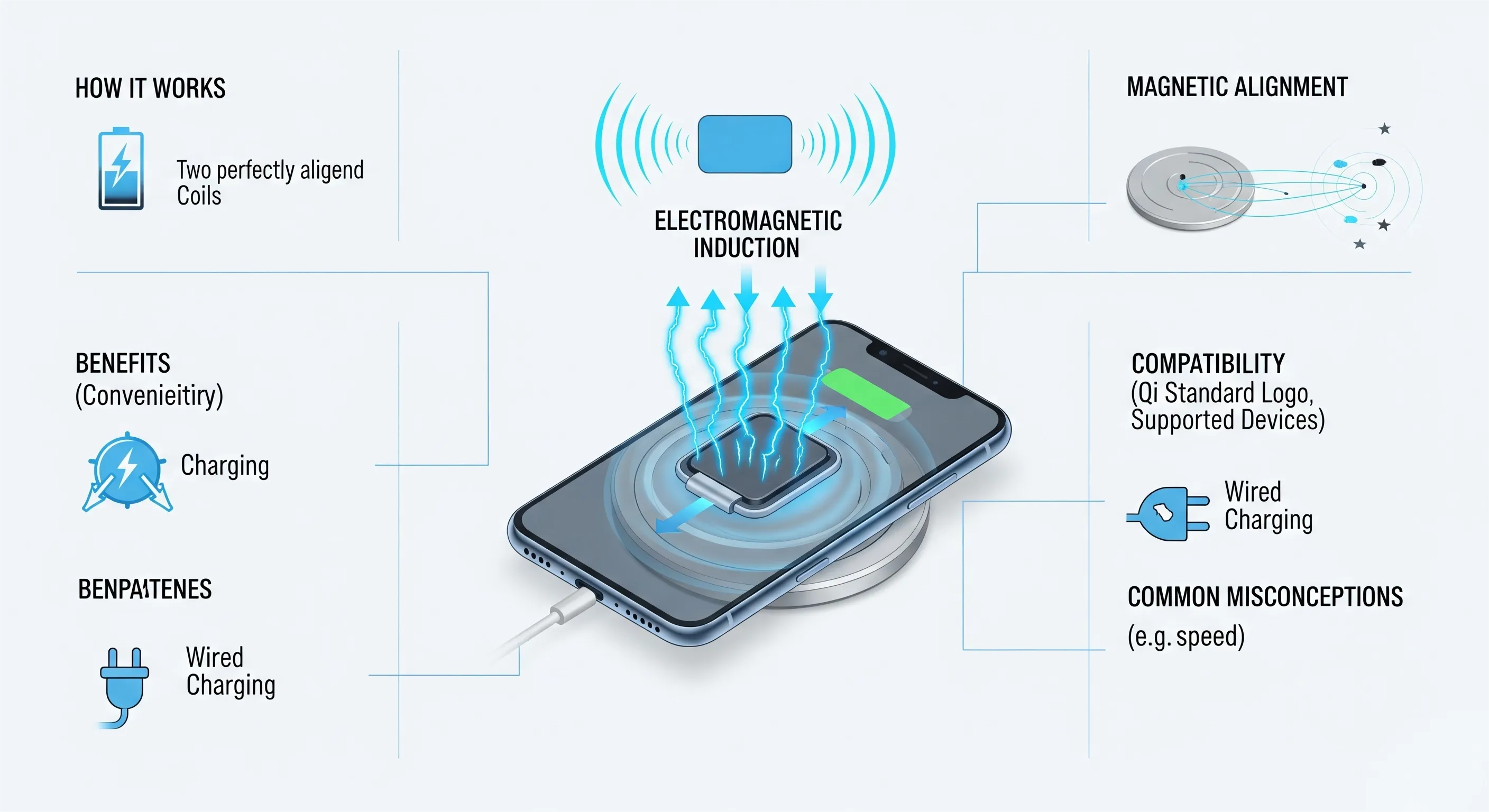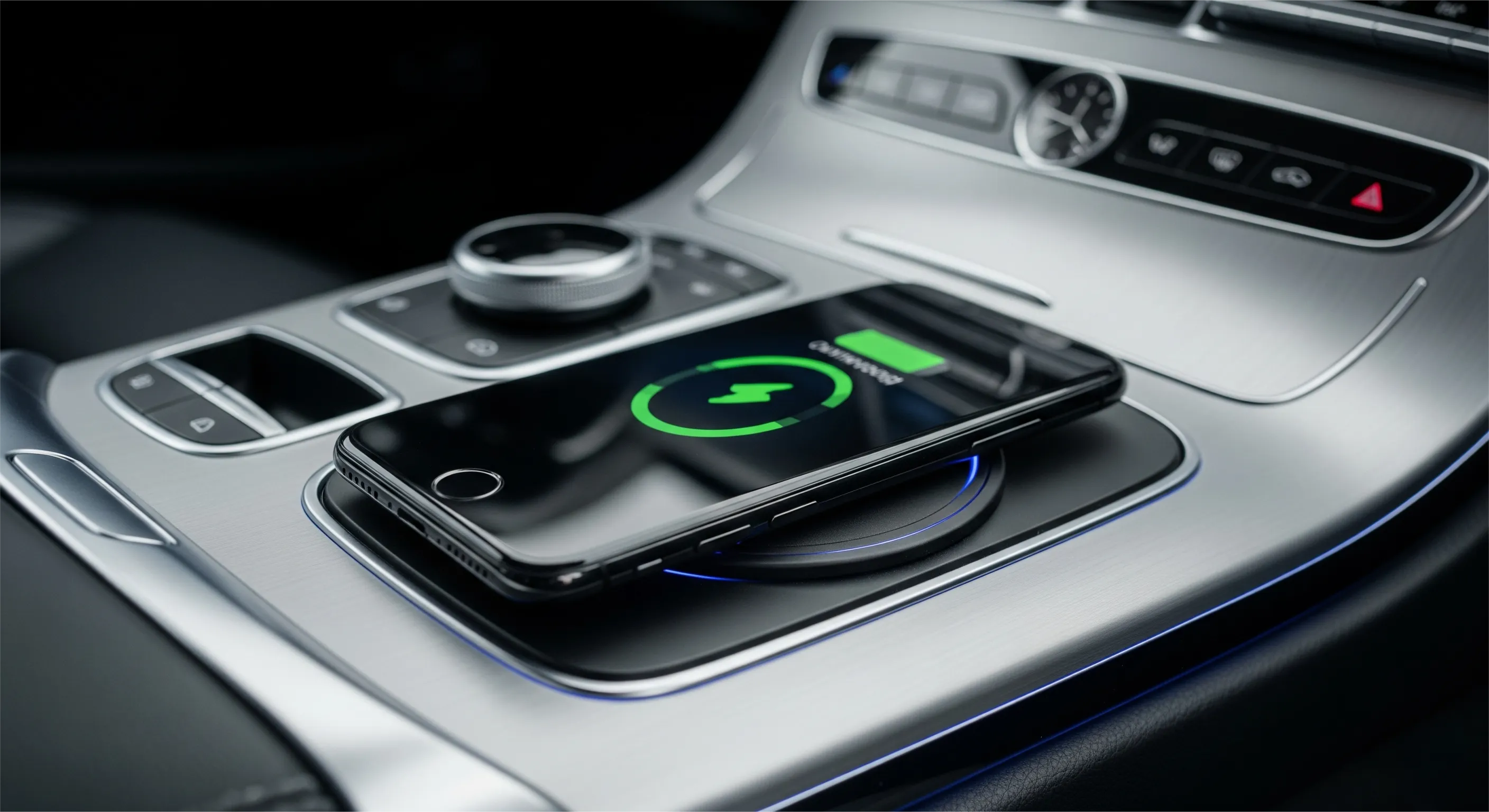Everything You Need to Know About Qi Wireless Charger Charging
The way we power our devices has changed a lot in recent years. Most of us can remember the hassle of digging through drawers for the right charging cable or untangling a knot of wires at the worst possible moment. Those days are slowly disappearing thanks to wireless charging, and the most widely adopted version is called Qi (pronounced “chee”).
Qi charging has become the global standard, offering a simple way to top up everything from smartphones and smartwatches to wireless earbuds. You’ll find it built into bedside tables, cars, airports, and coffee shops across Canada and around the world. The appeal is obvious: just set your device down on the pad and let it charge, no fuss.
This guide will cover everything you need to know, from how Qi charging actually works to the pros and cons, and why it’s become such a common part of modern life. But before diving into the benefits, it helps to understand the basic principles that make this technology possible.
What Is Qi Wireless Charger Charging?
Qi wireless charging is a non-contact charging technology that uses electromagnetic induction to deliver power. In simple terms, it lets compatible devices recharge their batteries just by resting on a charging pad or stand, no cables required. The convenience is easy to appreciate in everyday life. Picture a chilly Canadian winter morning: instead of fumbling with a frozen charging cable, you simply set your phone down on the pad built into your desk or nightstand, and it begins charging instantly. When discussing Qi vs Qi2 wireless charging differences, a key distinction lies in Qi2’s evolution from Qi: it not only delivers crucial enhancements in user perception but also introduces standalone capability, superior energy efficiency, and more reliable, secure fast-charging performance that sets it apart. The technology is already common in smartphones, wireless earbuds, and smartwatches, and its reach is expanding quickly as more devices adopt the Qi standard.


How Does a Qi Wireless Charging Mat Work?
Qi wireless charging relies on electromagnetic induction, a process where energy is transferred between two coils without direct contact. The charging pad, known as the transmitter, creates a magnetic field when powered on. A Qi-enabled device, such as a smartphone or earbuds case, contains a receiver coil that picks up this field and converts it into electricity, which is then used to recharge the battery. The whole process is automatic once the device is aligned with the pad, making it feel seamless; no cables to connect, no ports to wear out, just a smooth transfer of power whenever you set your device down.
Why Is Qi Wireless Charging So Popular?
The appeal of Qi wireless charging goes well beyond convenience; it represents a shift in how we live with our devices. Across Canada, from a quick recharge at a coffee shop in downtown Toronto to unwinding at a lakeside cabin in British Columbia, more places are offering Qi-enabled stations as part of daily life.
Universal Standard and Wide Compatibility
Qi is an open standard developed by the Wireless Power Consortium (WPC), which brings together major tech companies to ensure compatibility across brands. The idea is simple: any device that meets the Qi standard will work with any Qi-certified charger. This means you don’t need a separate charger for each device; the same pad can top up your iPhone, Samsung Galaxy, Google Pixel, or even certain wireless headphones and smartwatches. It removes the frustration of carrying different cables and makes everyday charging far more straightforward.
For Canadians who enjoy the outdoors or often spend long hours away from outlets, a versatile wireless power bank is particularly valuable. It reduces clutter, eliminates the need for spare cords, and provides flexibility wherever you are. A good example is the EcoFlow RAPID Mag Power Bank (10,000mAh), which combines a slim profile with strong magnetic attachment and advanced cooling technology. The result is a compact device that can reliably keep your phone charged on a camping trip, during a long hike, or even while travelling for work, giving you both convenience and peace of mind.
Effortless User Experience
No cables, no guessing which end of the cord goes where. With Qi, you simply place your device on the pad, and charging begins instantly. This drop-and-go design fits seamlessly into busy routines, making it one of the easiest tech habits to adopt.
Growing Ecosystem and Accessibility
The Qi ecosystem is expanding quickly as more devices and everyday items adopt the technology. Beyond smartphones and earbuds, many smartwatches and even pieces of furniture now feature built-in charging pads, blending power seamlessly into daily life. In Canada, Qi chargers are appearing in airports, hotels, coffee shops, and newer cars, making it easier than ever to keep your devices charged while travelling, commuting, or simply relaxing away from home.
Improved Technology and Speed
When Qi charging first appeared, many users found it underwhelming because of its slower pace compared to traditional cables. Leaving a phone on the pad often meant waiting much longer for a full charge, which limited its appeal in daily use.
Thanks to steady improvements, newer Qi chargers can now deliver 15W or more, a big leap from earlier models. This puts them much closer to the speeds we expect from wired charging, making wireless charging both convenient and efficient for everyday use.
Enhanced Safety Features
The Qi standard is designed with built-in safeguards to keep charging safe and reliable. One key feature is Foreign Object Detection (FOD), which prevents the pad from sending power if it detects metal objects like keys or coins. This reduces the risk of overheating, short circuits, or accidental damage, giving users an extra layer of protection whenever they charge their devices.
Future-Ready and Trend-Driven
As smart homes and the Internet of Things (IoT) continue to grow, Qi wireless charging is evolving into more than just a way to top up your phone. It’s becoming a standard method of powering an entire network of connected devices, from wearables and headphones to home gadgets and even smart furniture. This seamless integration positions Qi as a key part of the future tech ecosystem, where everyday items can stay powered without the hassle of cables.


Disadvantages of Qi Wireless Charging
While Qi wireless charging is convenient, it does have its limitations. Here’s a closer look at the drawbacks, with some real-world examples of when they might matter. Most people find that wireless charging works best as a convenient supplement rather than a complete replacement for traditional charging.
Slower Charging Speeds
Even though modern Qi chargers can reach up to 15W, they’re still slower than many fast wired chargers that can deliver 25W, 45W, or more. This difference is noticeable when you’re in a rush. For example, if you’re about to head out to work in the morning and your phone is at 15%, a wired charger could give you a significant boost in 10 minutes, while wireless may only add a small amount.
Limited Charging Distance
Qi charging requires your phone or device to sit directly on the pad. That means you can’t comfortably hold your phone to scroll through news headlines or reply to messages while it’s charging. Picture being in a Toronto cafe and needing to answer a few emails, with a cable, you can keep your phone in your hand, but with wireless, you’ll have to leave it on the table until you’re done.
Less Energy Efficient
Wireless charging isn’t as efficient as a wired connection. Some energy is lost during the transfer process, which means more electricity is used to get the same battery percentage. On a small scale, this isn’t dramatic, but if you’re charging multiple devices daily, say your phone, earbuds, and smartwatch, it can add up over time.
Device Heating
Because of that energy loss, wireless charging generates extra heat. It’s not unusual to pick up your phone after an hour on the pad and notice it feels warm. During long sessions, especially overnight, that warmth can slowly affect battery health. Imagine leaving your phone on the nightstand charger in the summer without air conditioning; the combination of heat from the room and the charger may shorten the battery’s lifespan.
Alignment Sensitivity
Your device has to be placed correctly on the pad for charging to work. Even a slight shift, like bumping the table or setting the phone down at an angle in the dark, can stop the process. This can be frustrating if you wake up to find your phone barely charged because it wasn’t sitting in the right spot overnight.
Compatibility Issues with Cases and Accessories
Wireless charging works best without anything interfering between the pad and the device. A slim silicone case usually isn’t an issue, but thicker rugged cases, or ones with magnetic attachments or metal rings for stands, can block charging entirely. Imagine buying a stylish new case for your iPhone only to find you now have to remove it every night just to use your wireless charger.
Cost
Finally, Qi chargers tend to cost more than wired chargers. A simple cable might be just a few dollars, while a reliable wireless pad or stand is often several times the price. If you want to set up multiple chargers around the house, one by the bed, one in the office, and one in the living room, the cost can add up quickly.
Common Applications of Qi Wireless Charging Pad
Qi wireless charging has evolved from a niche technology into something many of us use every day, often without even thinking about it. From desks and bedside tables to airports and cars, it’s becoming a standard feature that makes powering devices far more convenient. Here are a few of the most common ways you’ll come across it in daily life.
Wireless Power Banks and Portable Charging Solutions
When you’re out and about, whether hiking in the Rockies or enjoying a weekend by the Atlantic, a power bank can be a lifesaver. Qi-compatible versions add even more convenience, letting you charge without carrying spare cables. The EcoFlow RAPID 5,000mAh Mag Power Bank is a good example; at just 9.4 mm thick, it’s slim enough to slip into a pocket, yet it delivers fast top-ups, charging an iPhone 16 to 50% in just 36 minutes. Its strong 11N magnetic grip keeps your phone secure, while built-in X-Cooling prevents overheating. Even the power bank itself recharges quickly, reaching 50% in under an hour, which makes it a handy companion for both travel and daily commutes.
Built-in Qi Charging in Furniture and Public Spaces
Qi is also showing up in furniture and shared spaces. IKEA has begun adding wireless charging pads to lamps and nightstands, blending charging into home design without extra clutter. Public areas are catching on, too; many Canadian airports, hotels, and coffee shops now offer tables marked with the Qi symbol, letting you power up your phone while waiting for a flight or sipping your morning coffee.
In-Car Wireless Charging
Many modern vehicles now include Qi pads in the centre console, allowing drivers to keep their phones charged on the go. It’s especially practical for navigation-heavy trips, where battery drain can otherwise be a real issue.


Consumer Devices with Qi Support
Qi isn’t limited to phones. Earbuds like Apple’s AirPods Pro, Samsung Galaxy Buds, and a growing number of smartwatches can all be recharged wirelessly. This means you can often rely on a single charging pad to handle multiple devices, cutting down on clutter at home or at work.
MagSafe vs. Qi Wireless Charging
In any Qi vs MagSafe wireless charging comparison, it’s important to note that Apple’s MagSafe is essentially a more advanced version of the Qi standard, designed specifically for iPhones. While both rely on wireless charging, MagSafe adds magnets to lock the device into the perfect position, creating a more stable and efficient connection.
Technology Standard
MagSafe is Apple’s proprietary take on Qi. It builds on the same core principles but introduces magnetic alignment and faster charging capabilities, reaching up to 15W. Qi, on the other hand, is an open universal standard, used by a wide range of brands and devices.
Charging Speed
For iPhone users, the difference is clear. MagSafe can deliver up to 15W of power to supported iPhones, while most Qi chargers max out at 7.5W for Apple devices.
Alignment Method
MagSafe’s magnets snap the phone into the ideal position, ensuring efficient charging without guesswork. Qi chargers rely on manual placement, so if your phone isn’t centred properly, charging may slow down or stop altogether.
Compatibility
A MagSafe charger delivers full 15W speeds only with MagSafe-enabled iPhones. However, it will still work with other Qi devices, though at reduced speeds. A standard Qi charger remains the most versatile option, compatible with all Qi-enabled phones, earbuds, and accessories.
User Experience
For everyday use, MagSafe feels more seamless thanks to its magnetic attachment, which doubles as a way to keep the phone securely in place while charging. Qi chargers still offer simplicity, but they require more careful positioning to get the best results.
What Phones Are Qi-enabled?
Many modern smartphones now support Qi wireless charging, and the list continues to grow each year. Here are some of the most widely used models that are Qi-enabled (note that availability may vary, and newer releases often add support as well):
| Brand | Models |
|---|---|
| Apple | iPhone 8 and newer models (including iPhone X, 11, 12, 13, 14, 15 series) |
| Samsung | Galaxy S series (S6 and newer), Galaxy Note series (Note 5 and newer), Galaxy Z Fold and Z Flip series |
| Pixel 3 and newer models (including Pixel 4, 5, 6, 7, 8 series) | |
| LG | G series (G6 and newer), V series (V30 and newer) |
| Sony | Xperia series (some models) |
| Huawei | Mate series (Mate 20 Pro and newer), P series (P30 Pro and newer) |
FAQs About Qi Inductive Wireless Charging
How Long Does Qi Wireless Charging Take?
The time it takes to fully charge a device with Qi depends on three main factors: the battery size, the charger’s power output, and the overall efficiency of the process. In general, wireless charging is slower than wired charging. For most smartphones, a standard Qi charger might take two to four hours to go from low battery to full, compared to fast wired chargers that can often do the same job in under an hour. While it’s not the quickest method, Qi works best for overnight charging or for topping up throughout the day when speed isn’t the main concern.
Is Qi the Same as Wireless Charging Technology?
Not exactly. Wireless charging is the broader concept of transferring power without cables, and different standards exist to make it possible. Qi is one of those standards, which was developed by the Wireless Power Consortium (WPC), and it has become the most widely adopted. While other standards have been introduced over the years, Qi is now the universal option supported by nearly all major smartphone brands, which is why it’s often used interchangeably with the term “wireless charging.”
Qi Wireless Charging vs. Wired Charging: Which Is Better for You?
The better choice depends on what matters most in your daily routine. If you need fast charging speeds and don’t mind plugging in, wired charging still wins; it can top up a phone much quicker, making it ideal for people who are often on the go. On the other hand, if you prefer convenience and a clutter-free setup, Qi wireless charging is a great fit. Simply placing your phone on a pad at your desk or nightstand keeps your battery topped up without the hassle of cords. For many Canadians who spend long hours working from home or want a tidier living space, Qi offers a smoother, more relaxed charging experience.
How Can I Tell If My Wireless Charger Supports Qi?
The easiest way to know if a charger supports Qi is to look for the official “Qi” logo printed on the device or packaging. If you don’t see it, check the product manual or the manufacturer’s website for confirmation. A quick online search of the model number will also tell you whether it’s Qi-certified. Since Qi is the most common wireless charging standard today, most well-known brands clearly state compatibility to avoid confusion.
What Are the Best Qi Wireless Chargers for Travel?
For travel, the best options are compact and portable chargers that don’t take up much space in your bag. Foldable charging stands are handy for hotel stays, letting you prop up your phone while it charges on the nightstand. Another excellent choice is a wireless power bank, which keeps you powered up on flights, road trips, or hikes without needing an outlet. The EcoFlow RAPID Mag Power Bank, for example, is slim, fast, and practical; offering magnetic attachment, quick top-ups, and reliable performance on the go. With the right travel charger, you can keep your devices ready without packing a tangle of cables.
Conclusion
From its simple “drop and go” convenience to the wide range of compatible devices, Qi wireless charging is steadily transforming the way we power up. While it can’t yet match the speed or efficiency of the fastest wired chargers, the trade-off is a cleaner, cable-free setup that fits neatly into modern life. Whether you’re working in a bustling Canadian city or taking time away in the country, Qi charging makes it easier to keep your essential devices ready whenever you need them. It’s a small change that delivers big benefits in comfort and convenience, and it’s only going to become more common in the years ahead.